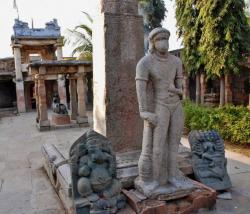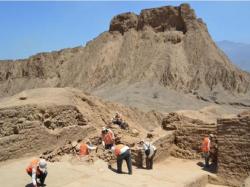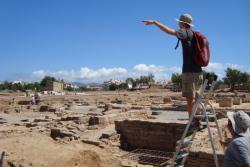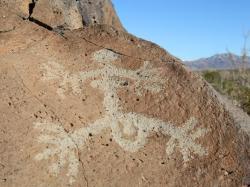INSTITUT SUPERIEUR D'ANTHROPOLOGIE
INSTITUTE OF ANTHROPOLOGY
ONLINE COURSES / COURS A DISTANCE
SPRING TERM : APRIL 2015
REGISTER NOW
INDE –  Kolanupaka - A five-foot-high idol of Matsya Vallabha, the son of Lord Anjaneya, located on the premises of the Kolanupaka Archaeological Museum here could be a special attraction to visitors. Archaeology Department officials say such an idol has not been found either in Telangana or Andhra Pradesh. Deputy Director at the Department of Archaeology and Museums J. Vijay Kumar said he had found the idol on the premises of a temple in 2002 at Kolanupaka. His seniors had marked it as an Anjaneya idol, but had also put a question mark on it. Mr. Vijay Kumar said he had observed the idol for days together and come to the conclusion that it was that of Matsya Vallabha since the rear of the statue was curved, like that of a mermaid’s back. Surprisingly, though Kolanupaka is famous for Shaivite temples, the rare idol belonged to the Vaishnavite sect, Mr. Vijay Kumar said. He said the idol could belong to the 15th or 16th century. He added that he had found a Matsya Vallabha idol on the wall of a Ranganayaka mandapa inside the Sri Venkateswara Swamy Temple in Tirumala. According to legend, Deergadehi, a fish or a mermaid, swallowed a drop of sweat from Anjaneya’s body while he was flying across the sea, and gave birth to Matsya Vallabha. Matsya Vallabha later became an associate of Mahiravana and kept the gates of the latter’s kingdom when he had had a fight with his father. They came to know about their relationship during the fight.
Kolanupaka - A five-foot-high idol of Matsya Vallabha, the son of Lord Anjaneya, located on the premises of the Kolanupaka Archaeological Museum here could be a special attraction to visitors. Archaeology Department officials say such an idol has not been found either in Telangana or Andhra Pradesh. Deputy Director at the Department of Archaeology and Museums J. Vijay Kumar said he had found the idol on the premises of a temple in 2002 at Kolanupaka. His seniors had marked it as an Anjaneya idol, but had also put a question mark on it. Mr. Vijay Kumar said he had observed the idol for days together and come to the conclusion that it was that of Matsya Vallabha since the rear of the statue was curved, like that of a mermaid’s back. Surprisingly, though Kolanupaka is famous for Shaivite temples, the rare idol belonged to the Vaishnavite sect, Mr. Vijay Kumar said. He said the idol could belong to the 15th or 16th century. He added that he had found a Matsya Vallabha idol on the wall of a Ranganayaka mandapa inside the Sri Venkateswara Swamy Temple in Tirumala. According to legend, Deergadehi, a fish or a mermaid, swallowed a drop of sweat from Anjaneya’s body while he was flying across the sea, and gave birth to Matsya Vallabha. Matsya Vallabha later became an associate of Mahiravana and kept the gates of the latter’s kingdom when he had had a fight with his father. They came to know about their relationship during the fight.
http://www.thehindu.com/news/national/telangana/rare-idol-of-matysa-vallabha-an-attraction-at-kolanupaka/article6796171.ece?homepage=true
PEROU –  Lambayeque - Nearly US$ 1.71 million will be allocated for archaeological research and studies necessary for excavations in Lambayeque’s 11 archaeological sites. Projects will re-commence with these new funds as they had been postponed. However, for 2015, a total budget of US$ 4.210 million will be going for the Naylamp-Lambayeque Special Project that will be for the management of the monuments and six museums, according to the project director, Carlos Aguilar. The musuems include Brüning, Tumbas Reales de Sipán, Sicán, Túcume, Huaca Rajada-Sipán and Chotuna-Chornancap).
Lambayeque - Nearly US$ 1.71 million will be allocated for archaeological research and studies necessary for excavations in Lambayeque’s 11 archaeological sites. Projects will re-commence with these new funds as they had been postponed. However, for 2015, a total budget of US$ 4.210 million will be going for the Naylamp-Lambayeque Special Project that will be for the management of the monuments and six museums, according to the project director, Carlos Aguilar. The musuems include Brüning, Tumbas Reales de Sipán, Sicán, Túcume, Huaca Rajada-Sipán and Chotuna-Chornancap).
http://www.peruthisweek.com/news-lambayeque-to-invest-us-171-million-to-archaeology-105018
ESPAGNE –  Majorque - On the Mediterranean island of Mallorca in Spain lie the remains of a Byzantine settlement, known as Son Peretó, where archaeological excavations are underway. Inhabited from the 5th century CE to about the 7th century CE, Son Peretó was home to a Christian population and is perhaps the most significant Byzantine settlement in the islands. What makes the site so interesting to archaeologists is its importance as an example of early Christian architecture. The site features a baptistery and a basilica, and a number of human remains in noteworthy condition have been revealed. “The current project,” write the Son Peretó project staff, “managed by the Manacor Historical Museum and the University of Barcelona, began in 2005, and since then our goal has been to preserve and restore the ruins uncovered during the 20th-century excavations, especially the foundations of several walls and untouched graves. So far the graves uncovered have been found in excellent condition.”The dig has been a continuous effort, and every summer Son Peretó yields new discoveries. The leaders of the excavation are calling for dig participants who will help the archaeologists acquire a higher understanding of the baptistery and the basilica.
Majorque - On the Mediterranean island of Mallorca in Spain lie the remains of a Byzantine settlement, known as Son Peretó, where archaeological excavations are underway. Inhabited from the 5th century CE to about the 7th century CE, Son Peretó was home to a Christian population and is perhaps the most significant Byzantine settlement in the islands. What makes the site so interesting to archaeologists is its importance as an example of early Christian architecture. The site features a baptistery and a basilica, and a number of human remains in noteworthy condition have been revealed. “The current project,” write the Son Peretó project staff, “managed by the Manacor Historical Museum and the University of Barcelona, began in 2005, and since then our goal has been to preserve and restore the ruins uncovered during the 20th-century excavations, especially the foundations of several walls and untouched graves. So far the graves uncovered have been found in excellent condition.”The dig has been a continuous effort, and every summer Son Peretó yields new discoveries. The leaders of the excavation are calling for dig participants who will help the archaeologists acquire a higher understanding of the baptistery and the basilica.
VIDEO = https://www.youtube.com/watch?v=tWd8U1fuawY
http://popular-archaeology.com/issue/june-2013/article/archaeospain-calls-for-participants-in-mallorca-excavation-of-a-byzantine-settlement
USA –  Twentynine Palms - The lava that encases this massive swath of desert spewed from a nearby volcano about 50,000 to 100,000 years ago, said John Hale, archeologist for the National Resources and Environment Affairs Division at the combat center. “This predated the arrival of man,” Hale said while striding across the vast rubble field. The natural resources division, in compliance with federal law, conducts ongoing surveys and evaluations at the combat center. “It’s a process that’s defined in the National Historic Preservation Act, which requires us to evaluate all the sites on base for national register eligibility,” Hale said. To date, about 67 percent of the installation has been inventoried for cultural resources and more than 300,000 artifacts have been collected, cataloged and housed at the Archeology and Paleontology Curation Center at the combat center — the only facility of its kind in the Marine Corps. Most of these artifacts are rocks and stones, including arrowheads and milling slabs, but there are also pottery shards and bones of prehistoric creatures, including a mastodon and horse. About 10,000 years ago, Native Americans first made their appearance on these lands. The discovery of prehistoric tool-stone quarries, lithic (stone fragments) scatters, habitation sites and rock art provides a glimpse into the lives of its occupants at the time — the Mojave, Serrano, Cahuilla and Chemehuevi Indians. On Tuesday, two archeologists scratched just below the thin crust of the the rubbly surface, down into the sand, looking for debitage, or thin slices chipped away during the process of fashioning a stone tool from a solid rock. Tucked into this craggy, moon rock-like rubble beneath our feet were traces of the existence of early man. “This site was originally surveyed in 1990,” said Scott Kremkau, senior project director for Statistical Research, Inc., as he watched the team scrape and sift a small square section of sand. A scorpion, disturbed by the activity, lurked nearby. “It was originally recorded as a lithics (rock fragment) scatter through here.” The earlier surveyors also noted, on a crude map drawn up at the time, the presence of prehistoric trail segments — indicated by a few random dots and lines.
Twentynine Palms - The lava that encases this massive swath of desert spewed from a nearby volcano about 50,000 to 100,000 years ago, said John Hale, archeologist for the National Resources and Environment Affairs Division at the combat center. “This predated the arrival of man,” Hale said while striding across the vast rubble field. The natural resources division, in compliance with federal law, conducts ongoing surveys and evaluations at the combat center. “It’s a process that’s defined in the National Historic Preservation Act, which requires us to evaluate all the sites on base for national register eligibility,” Hale said. To date, about 67 percent of the installation has been inventoried for cultural resources and more than 300,000 artifacts have been collected, cataloged and housed at the Archeology and Paleontology Curation Center at the combat center — the only facility of its kind in the Marine Corps. Most of these artifacts are rocks and stones, including arrowheads and milling slabs, but there are also pottery shards and bones of prehistoric creatures, including a mastodon and horse. About 10,000 years ago, Native Americans first made their appearance on these lands. The discovery of prehistoric tool-stone quarries, lithic (stone fragments) scatters, habitation sites and rock art provides a glimpse into the lives of its occupants at the time — the Mojave, Serrano, Cahuilla and Chemehuevi Indians. On Tuesday, two archeologists scratched just below the thin crust of the the rubbly surface, down into the sand, looking for debitage, or thin slices chipped away during the process of fashioning a stone tool from a solid rock. Tucked into this craggy, moon rock-like rubble beneath our feet were traces of the existence of early man. “This site was originally surveyed in 1990,” said Scott Kremkau, senior project director for Statistical Research, Inc., as he watched the team scrape and sift a small square section of sand. A scorpion, disturbed by the activity, lurked nearby. “It was originally recorded as a lithics (rock fragment) scatter through here.” The earlier surveyors also noted, on a crude map drawn up at the time, the presence of prehistoric trail segments — indicated by a few random dots and lines.
http://www.desertsun.com/story/news/2015/01/16/marine-corps-archeological-dig/21892001/
IRAN - Tappeh Dasht - Head of the archeology group at Tappeh Dasht, north of Sistan and Baluchestan Province, Mehdi Mortazavi said Tappeh Dasht is a workshop for producing clay in a 5.7-hectare area, 3 km from southwest of the Burnt City in north of Sistan and Baluchestan province. According to the preliminary excavations, its antiquity dates back to the second era of inhabitance in the Burnt City, that is to say 2,800 years B.C. Pointing to continuation of excavations for finding out major points in the archeology he said the second season of excavations in the area was conducted for a period of 30 years, ending on December 30, in which 12 members of the archeological delegation worked together with a technical expert. The archeologist further remarked that simultaneously with the excavations, the team stereotyped another furnace resembling the one which was used in the past with the exception that the dimensions, capacity and standards of this furnace were different from the one used in Tappeh Dasht. According to him, the temperature resulted from the burning of a few pieces of animal fertilizer in this furnace, which was not made scientifically, was 288 centigrade. In addition, he noted, fingerprints on the surplus clay which had been cut from the clay work while shaping it and throwing it out is among other findings of the archeologists. These fingerprints will help to identify the sex and even the age of the individual who used to work there. Some stone pieces belonging to animals and a tooth which apparently belonged to a 7 to 8 year-old child have been discovered in that area. Commenting on generation of energy from animal fertilizer he said this is an art which shows at that time people had found out that when the livestock feeds on plants it will be a source of reserving energy and after its excretion it can be used as fuel. He said the main findings of the two seasons of excavations in the area included fabric, human effigies, clay baking furnace and fingerprints which will clarify many ambiguous points.
http://www.irna.ir/en/News/81469337/?